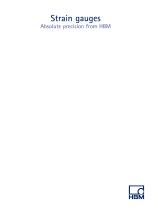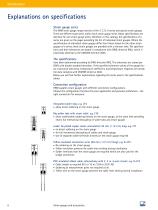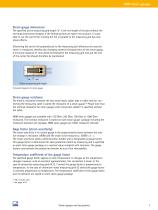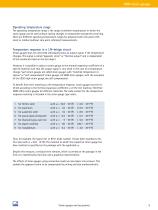Catalog excerpts

HBM strain gauges © Hottinger Baldwin Messtechnik GmbH. All rights reserved. All details describe our products in general form only. They are not to be understood as express warranty and do not constitute and liability whatsoever. Strain Gauges Absolute precision from HBM HBM Test and Measurement
Open the catalog to page 1
Strain gauges Absolute precision from HBM
Open the catalog to page 3
From measured strain to mechanical stress... 12 The easy way to find the right strain gauge 14 with 1 measuring grid / linear SG 20 with 2 measuring grids / double SG 24 with 2 measuring grids / T rosette 25 with 2 measuring grids / Shear/torsion SG / T rosette 27 with 2 measuring grids / Torsion/shear SG 28 with 3 measuring grids / rosettes 29 with 4 measuring grids / full bridges 33 with 4 measuring grids / diaphragm rosettes 34 SG with connection cable K-LY.../K-XY.../K-RY.../K-DY... 39 (incl. Teflon wire) with 1 measuring grid 41 (incl. Teflon wire) with 2 measuring grids 42 (incl....
Open the catalog to page 4
Encapsulated SG with 3m (10 ft) stranded connection wire 54 Encapsulated SG with stranded wire 55 Strain gauges for integration in composites 58 Pressure measurement gauge 60 Crack propagation gauges 61 SG for determination of residual stress 63 Integral hole drilling method 68 Customized strain gauges 69 Cleaning agents, gluing and soldering materials 75 Cables and stranded wires 77 Bridge completions/resin-cored solder/lead-free solder 80 Optical strain gauges 86 HBM Strain gauges and accessories
Open the catalog to page 5
Explanations on specifications Strain gauge series The HBM strain gauge range consists of the Y, C, G, V series and special strain gauges. There are different type series within each strain gauge series. Many specifications are identical for one strain gauge series; therefore, in this catalog, the specifications of a series are given on the pages preceding the list of individual strain gauges. Where the specifications of individual strain gauges differ from those stated for the other strain gauges of a series, these strain gauges are provided with a relevant note. The specifications and...
Open the catalog to page 6
Strain gauge dimensions The specified active measuring grid length “a” is the net length of the grid without the end loops (transverse bridges). If the following facts are taken into account, it is possible to cut the carrier foil: Cutting the foil in parallel to the measuring grid has only minor effects. Shortening the carrier foil perpendicular to the measuring grid influences the way the strain is introduced, thereby also changing essential characteristics of the strain gauge. A minimum distance of 1mm (0.04 inch) between the measuring grid end and the end of the carrier foil should...
Open the catalog to page 7
Maximum permissible effective bridge excitation voltage A strain gauge is a resistor, converting electrical energy into heat. To prevent heating of the strain gauge it is essential to choose a supply voltage that is not excessively high. The maximum permissible bridge excitation voltage is calculated for each strain gauge and is listed in a table in this catalog. The specified excitation voltage always applies for the Wheatstone bridge as a whole. Only half the voltage may be applied to the individual strain gauge. The maximum values specified are permissible only for application on...
Open the catalog to page 8
Operating temperature range The operating temperature range is the range of ambient temperatures in which the strain gauge can be used without lasting changes in measurement properties occurring. There are different operating temperature ranges for absolute (with zero point reference) or relative (without zero point reference) measurements. Temperature response in a 1/4-bridge circuit Strain gauges that are connected individually show an output signal, if the temperature changes. This signal is called “apparent strain” or “thermal output” and is independent of the mechanical load on the...
Open the catalog to page 9
The temperature response involves a tolerance and only applies in the temperature range of the temperature response matching. This temperature range is specified in the specifications of the individual series in this catalog. Another possibility of compensating the apparent strain is to use appropriate wiring (e.g. circuit with compensating strain gauge, half bridge circuit, etc.). Mechanical hysteresis The mechanical hysteresis of a strain gauge is defined as the difference of the measured value displayed for increasing and decreasing strain loadings with the same strain value on the...
Open the catalog to page 10
Minimum radius of curvature The flexibility of a strain gauge is characterized by the minimum radius of curvature which it will withstand, without any auxiliary measures, in each direction respectively. The polyimide carriers of Y and C series strain gauges are flexible to an extent that they can be bonded around edges. Although the carrier materials of the other strain gauge series are more brittle, they can also be easily prepared for application to smaller radii by thermal pre-forming Exception: V series strain gauges have a bigger radius of curvature because of their specific potting....
Open the catalog to page 11
From measured strain to mechanical stress ... Analysis of the biaxial stress state with unknown principal directions The principle of experimental stress analysis using strain gauges (SG) consists in using strain gauges to measure strains on the component surface. From these measured strains and the known material properties (modulus of elasticity and Poisson’s ratio), the absolute value and the direction of these mechanical stresses are determined. These calculations are based on Hooke’s Law which applies to the elastic deformation range of linear-elastic materials. In experimental stress...
Open the catalog to page 12
The principal directions are determined below. First the tangent of an auxiliary angle \\i For the 0°/45°/90° rosette using the formula: and for the 0°/60°/120° rosette according to the formula: Note: The tangent of an angle in the right-angled triangle is the ratio of the opposite side (numerator N) to the adjacent side (denominator D): This ambiguity of the tangent makes it necessary to determine the signs of the numera- tor (N) and the denominator (D) before carrying out the final calculation of the two above mentioned quotients. Determining the signs is important because they alone...
Open the catalog to page 13All HBM Test and Measurement catalogs and technical brochures
-
K3607
2 Pages
-
K800
2 Pages
-
DSE-HIE
8 Pages
-
PW37P
4 Pages
-
FS62WSR
3 Pages
-
FS62PSR
3 Pages
-
PACEline
10 Pages
-
PMX Measuring amplifier system
16 Pages
-
QuantumX
14 Pages
-
Pressure
8 Pages
-
Torque T40B
8 Pages
Archived catalogs
-
Digital Weighing Brochure
8 Pages
-
Strain Gages and Accessories
100 Pages























